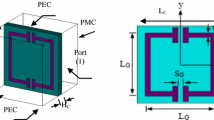Abstract
This paper introduces a graphene metamaterial (GMM) transmitarray designed for terahertz applications. The unit-cell element is a multilayered metamaterial structure of a graphene split ring resonator with two variable gaps. The metamaterial properties of the unit-cell element are investigated from 0.74 to 0.94 THz for different conductivities of the graphene material. A parametric study of the transmission properties of the metamaterial unit-cell element is investigated. The radiation characteristics of 169 unit-cell elements of the three layers GMM transmitarrays are analyzed for different applied DC voltages. The gain and side-lobe level of the proposed transmitarray are improved by using an averaging process on the transmission phase used for array construction. The transmitarray introduces a high gain of about 18.5 dB at frequencies 0.83, 0.85 and 0.88 THz for chemical potentials μc = 0.4, 0.5 and 0.8 eV, respectively. A full wave simulation is used to design and analyze the radiation characteristics of the graphene based metamaterial transmitarray.














Similar content being viewed by others
References
Song, H.-J., & Nagatsuma, T. (2015). Handbook of terahertz technologies: Devices and applications. Boca Raton: CRC Press.
Zhang, X. C. (2002). Terahertz wave imaging: Horizons and hurdles. Physics in Medicine & Biology, 47(21), 3667.
Kawase, K., Ogawa, Y., Watanabe, Y., & Inoueet, H. (2003). Non-destructive terahertz imaging of illicit drugs using spectral fingerprints. Optics Express, 11(20), 2549–2554.
Shelton, D. (2010). Tunable infrared metamaterials. Ph.D. Thesis, University of Central Florida, Florida, USA.
Tao, H., Bingham, C. M., Strikwerda, A. C., Pilon, D., Shrekenhamer, D., Landy, N. I., et al. (2008). Highly flexible wide angle of incidence terahertz metamaterial absorber: Design, fabrication, and characterization. Physical Review B, 78(24), 241103.
Grant, J., Ma, Y., Saha, S., Khalid, A., & Cumming, D. (2011). Polarization insensitive, broadband terahertz metamaterial absorber. Optics Letters, 36(17), 3476–3478.
Wang, B. X., Zhai, X., Wang, G. Z., & Huang, W. Q. (2015). A novel dual-band terahertz metamaterial absorber for a sensor application. Journal of Applied Physics, 117(1), 014504.
Chiam, S. Y., Singh, R., Rockstuhl, C., Lederer, F., Zhang, W., Chiam, S.-Y., et al. (2009). Analogue of electromagnetically induced transparency in a terahertz metamaterial. Physical Review B, 80(15), 153103.
Choi, W., & Lee, J. (2012). Graphene: Synthesis and applications. Boca Raton, FL: CRC Press.
Bao, W. (2012). Electrical and mechanical properties of graphene. Ph.D. Thesis, University of California Riverside, USA.
Hanson, G. W. (2008). Dyadic green’s functions for an anisotropic, non-local model of biased graphene. IEEE Transactions on Antennas and Propagation, 56(3), 747–757.
Rouhi, N., Capdevila, S., Jain, D., Zand, K., Wang, Y., Brown, E., et al. (2012). Terahertz graphene optics. Nano Research Journal, 5(10), 667–678.
Tamagnone, M., Gómez-Díaz, J. S., Mosig, J. R., & Perruisseau-Carrier, J. (2012). Analysis and design of terahertz antennas based on plasmonic resonant graphene sheets. Journal of Applied Physics, 112(11), 114915.
Malhat, H. A., & Zainud-Deen, S. H. (2015). Equivalent circuit with frequency independent lumped elements for plasmonic graphene patch antenna using particle swarm optimization technique. Wireless Personal Communications, 85(4), 1851–1867.
Liu, L., & Hattori, H. T. (2015). Tunable terahertz metamaterials based on ultra-subwavelength graphene-dielectric structures. In 20th microoptics conference, Fukuoka (pp. 1–2).
Gaber, S. M., Zainud-Deen, S. H., Malhat, Hend A., & Awadalla, K. H. (2014). Analysis and design of reflectarrays/transmitarrays antennas. Saarbrücken: Lap Lambert Academic Publishing.
Zainud-Deen, S. H., Hassan, W., & Malhat, H. A. (2016). Bi-function multi-beam graphene lens antenna for terahertz applications. Wireless Engineering and Technology, 7(1), 36–45.
Malhat, H. A., Zainud-Deen, S. H., & Gaber, S. M. (2014). Graphene based transmitarray for terahertz applications. Progress in Electromagnetics Research M, 36, 185–191.
Liu, L., & Hattori, H. T. (2005). Tunable terahertz metamaterials based on ultra-subwavelength graphene-dielectric structures. In 20th Microoptics conference (MOC), Fukuoka (pp. 1–2).
El-Araby, H. A., Malhat, H. A., & Zainud-Deen, S. H. (2017). Performance of nanoantenna-coupled geometric diode with infrared radiation. In IEEE 34th national radio science conference (NRSC) (pp. 15–21).
Reis, J., Al-Daher, R. Z., Copner, N., Caldeirinha, R., Fernandes, T. (2015). Two-dimensional antenna beamsteering using metamaterial transmitarray. In 9th IEEE european conference on antennas and propagation (pp. 1–5).
Maruyama, T., Furuno, T., Oda, Y., Shen, J., & Kayama, H. (2011). Study of frequency band width for multi-layer mushroom reflectarray with parasitic patches. In IEEE international symposium on antennas and propagation (APSURSI) (pp. 691–694).
Abdollahramezani, S., Arik, K., Farajollahi, S., Khavasi, A., & Kavehvash, Z. (2015). Beam manipulating by gate-tunable graphene- based metasurfaces. In 23rd iranian conference electrical engineering (ICEE) (pp. 534–539).
Foo, S. (2006). Metamaterial-based transmitarray for orthogonal beam-space massive-MIMO. In 10th european conference on antennas and propagation (EuCAP) (pp. 1–5).
Zainud-Deen, S. H., Mabrouk, A. M., & Malhat, H. A. (2017). Frequency tunable graphene metamaterial reflectarray. In XXXII international union of radio science general assembly & scientific symposium, Canada.
Marklein, R. (2002). The finite integration technique as a general tool to compute acoustic, electromagnetic, elastodynamic, and coupled wave fields (pp. 201–244). New York: IEEE Press.
Author information
Authors and Affiliations
Corresponding author
Rights and permissions
About this article
Cite this article
Zainud-Deen, S.H., Mabrouk, A.M. & Malhat, H.A.EA. Terahertz Graphene Based Metamaterial Transmitarray. Wireless Pers Commun 100, 1235–1248 (2018). https://doi.org/10.1007/s11277-018-5630-8
Published:
Issue Date:
DOI: https://doi.org/10.1007/s11277-018-5630-8




